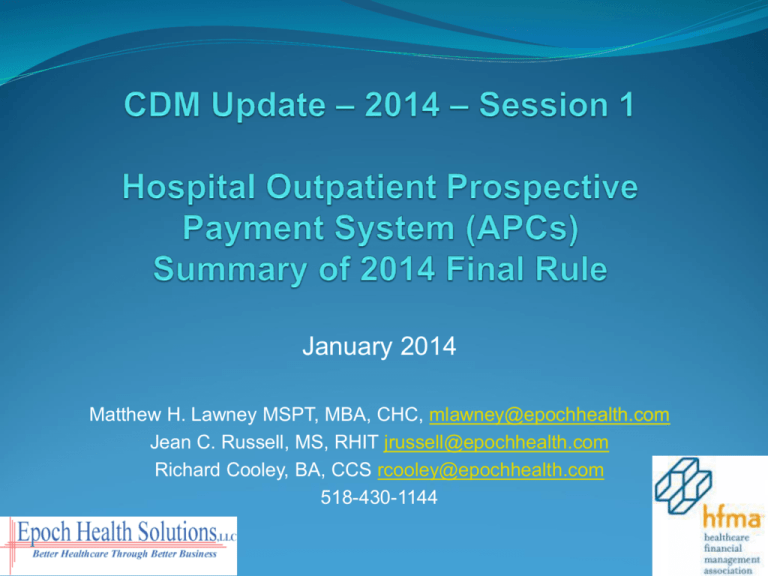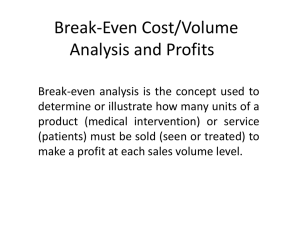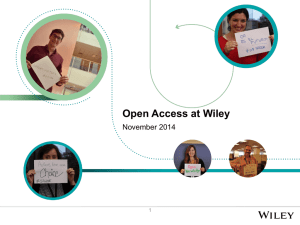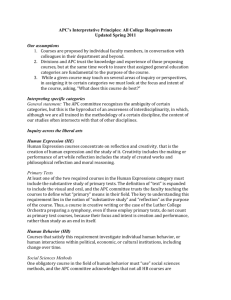
January 2014
Matthew H. Lawney MSPT, MBA, CHC, mlawney@epochhealth.com
Jean C. Russell, MS, RHIT jrussell@epochhealth.com
Richard Cooley, BA, CCS rcooley@epochhealth.com
518-430-1144
2
Agenda
•
•
•
•
•
•
APC Reimbursement Impact
Comprehensive APCs
Packaging Changes
•
1. Drugs/biologicals/radiopharm dx tests
•
2. Drugs/biologicals/radiopharm surgical procedures
•
3. Clinical dx lab tests
•
4. Add-on procedures
•
5. Ancillary services (APC status X)
•
6. Dx tests on bypass list
•
7. Device removal procedures
Physician Supervision
Other Changes – I/P Only Procedures
Quality Reporting
3
Abbreviations
APC – Ambulatory Patient Classification
ASP – Average Sales Price
CAH – Critical Access Hospital
EACH – Essential Access Community Hospital
MPFS – Medicare Physician Fee Schedule
NPP – Non-Physician Practitioners
OPPS – Outpatient Prospective Payment System
PHP – Partial Hospitalization Program
RCC – Ratio of Costs to Charges
SCH – Sole Community Hospital
SI – APC Status Indicator
WAC – Wholesale Acquisition Cost
4
APC Reimbursement
5
Payment Impact
Hospitals that met the quality indicator reporting
requirements will get the full 1.7% (1.8% in 2013)
payment rate increase factor
2.0% reduction in payment update factor if hospital did not
meet the quality indicator reporting requirements
Conversion factor increased from $71.313 in 2012 to
$72.672 for hospitals that meet quality reporting
standards
2% reduction conversion factor would be $71.219
6
Cancer Centers
The 11 cancer centers continue to receive
a payment adjustment
Ensuring they do not receive a lower payment under
OPPS than what they received prior to 2000
Rural adjustment will be continued at 7.1%
for rural Sole Community Hospitals
(SCHs), including Essential Access
Community Hospitals (EACHs)
7
Outlier Calculations
Calculation methodology unchanged
1st Threshold:
Line-item cost exceeds 1.75 times APC payment
2nd Threshold:
Line-item cost exceeds APC payment plus $2,900
The threshold is higher compared to $2,025 last year
When both thresholds met
Outlier payment = 50% * Cost – 1.75 * APC payment
50% of the cost that exceeds 1.75 times APC payment
[cost = charges * RCC]
8
Deductible Changes
Inpatient deductible has increased from:
$1,132 (2011) to $1,156 (2012) to
$1,184 (2013) to $1,216 (2014)
Inpatient hospital coinsurance increased from:
$296 (2013) to $304 (2014)
Part B deductible has changed from:
$166 (2011) to $140 (2012) to
$147 (2013) with no change in 2014 ($147)
9
Comprehensive APCs
10
Proposed Rule
Create 29 Comprehensive APCs with one payment
made for the primary service plus all adjunctive
services performed to support that service
These were developed from the 29 highest cost
device dependent APCs
There will be a new status indicator (J1) to identify
the 136 HCPCS codes which map to the 29
comprehensive APCs
11
Proposed Rule
A single payment will be made that includes the
following when performed as part of the service:
All DME items
Rehab codes, including PT/OT/ST
All drugs, except pass-through drugs, including self-
administered drugs
Recovery and extended recovery and observation
services
Two or more comprehensive APC procedures will
result in payment for the higher paid procedure
Add-on procedures
12
Final Rule
Comprehensive APCs have been FINALIZED
But delayed until 1/1/2015
Extra time to allow hospitals to perform a thorough
analysis of the impact of this change so that they can
implement changes
CMS will apply a “degree of complexity” to each J1
procedure
Table 10 identifies which comprehensive codes will
be reassigned to a higher (more complex)
comprehensive APC
13
Table 10 – Complexity Reassignments
14
Comprehensive APCs
This proposal has been finalized, but
delayed
There are still outstanding questions
Watch for further clarification and
transmittals during the year
Analyze the impact for your hospital and
make changes (if possible)
15
16
17
Packaging
18
Packaging
No major changes to any Status
Indicators
Significant changes to packaging
Status Indicator N - Unconditionally
packaged services
Always considered integral to the
primary service
19
Packaging
Conditionally packaged services - Composites
Review of the Composite Status Indicators:
“Q1” - “STVX-packaged codes”
“Q2” - “T-packaged codes”
“Q3” – Procedure codes that may be paid
through a composite APC based on
composite-specific criteria or separately
through single code APCs when composite
criteria is not met
20
Original Composite APCs
1. Mental Health Services – Partial
Hospitalization
2. Low dose prostate brachytherapy
3. Cardiac EP (electrophysiologic) evaluation and
ablation services
4. Extended ED observation and monitoring
5. Extended Clinic observation and monitoring
21
Multiple Imaging Services
Added in 2009 - five imaging composite APCs
Single APC payment for two or more imaging
procedures provided using same imaging modality
The imaging composite APCs are:
1.
2.
3.
4.
5.
Ultrasound
CT and CTA w/o contrast
CT and CTA with contrast
MRI and MRA w/o contrast
MRI and MRA w/contrast
22
Partial Hospitalization
The most intensive outpatient psychiatric service
Consists of 4 or more services per day
If the payment amount for multiple mental health
services provided during a single day exceeds this
payment, the payment will be capped at the partial
hospitalization composite rate (APC 0034)
Payment for APC 0034 – 2013 - $228.26
Payment for APC 0034 – 2014 - $213.64
23
Cardiac Resynchronization
Therapy (APC 108)
Created in 2012 – Combination of 33225,
insertion of a pacing electrode, reported with
33249, insertion of an ICD
Unusual “composite” in that the payment is the
same w/ and w/o the additional reporting of
33225
That is, 33225 is essentially unconditionally
packaged
APC 108 will be part of the 29 comprehensive
APCs delayed until 2015
24
Composite Rate Changes
25
The Proposed/Finalized
Packaging Changes
Addendum P in Final Rule
26
1. Drugs/Biologicals/Radiopharm Dx
Tests
In 2013, the following drugs are APC status N
(unconditionally packaged) unless status G (passthru):
Drugs with a per day cost less than threshold
Diagnostic radiopharmaceuticals
Contrast agents
Anesthesia drugs
Drugs used as a supply
Implanted biologicals
27
1. Drugs/Biologicals/Radiopharm Dx
Tests
For 2014, CMS is adding two more categories of
diagnostic drugs unconditionally packaged
Stress Agents
HCPCS Code C9275, Injection, hexaminolevulinate
hydrochloride, 100 mg, per study dose
28
2. Drugs/Biologicals/Radiopharm Dx
Surgical Procedures
These changes were implemented, more information
to follow in the wound care session
29
3. Clinical Diagnostic Lab Tests
CMS finalized the changes as proposed to packaged
all diagnostic lab tests in OPPS billed with a bill
type 131 whether they are integral, ancillary,
supportive, dependent or adjunctive to a primary
service!
The only time they are not packaged is if they are
billed on a bill type 141, they must be billed on a
bill type 141 if they are:
The only service (i.e., referred lab), may be billed with
a 36415, venipuncture
Or, if they are ordered for a different purpose by a
different practitioner
30
3. Clinical Diagnostic Lab Tests
This application of bill type 141 conflicts with the
definition
According to the NUBC, a bill type 141 should be
reported only for a referred, outside lab
Bill type 141 is not usually reported for cases where
the patient came to the hospital for the blood draw or
other services
31
4. Add-on Procedures
CMS proposed to package unconditionally (i.e., APC
SI “N”) all add-on procedures
Commenters were concerned that this would not
adequately cover the cost of doing these services
CMS finalized to unconditionally package all add-ons
with two exceptions:
Drug administration payable add-on codes (e.g.,
96375, 96366)
2. Add-on codes currently assigned to device
dependent APCs (see Table 15) – These will be
packaged with the inception of comprehensive APCs
1.
32
5. Ancillary Services (APC SI X)
CMS proposed to package all services currently
assigned to APC SI X, with a few exceptions, such
as:
Preventative services
Effectively removing this status indicator X and
changing the definition of Q1 from STVX to STV
packaged
Commenters were again concerned that this type of
service is not always “ancillary” to the services
CMS agreed and did not implement this proposal
33
5. Ancillary Services (APC SI X)
One exception to this is 93017, stress test
This code has been changed from APC SI X to a
conditionally packaged code, APC SI Q1
It will not be paid when another APC SI S, T, V or X
procedure is performed
34
6. Dx Tests on Bypass List
There are certain procedures that have limited
associated packaged costs when calculating APC
rates as described in the OPPS final rule
These are on the “bypass list”
CMS proposed to have these procedures
conditionally packaged
Commenters were not thrilled about this
CMS did not implement this change
35
7. Device Removal Procedures
CMS finalized the proposal to conditionally package
separately coded device removal procedures when
they are performed with a repair or replacement of a
device
These have been assigned to APC SI Q2 (T
packaged)
Appendix P includes a list of these conditionally
packaged procedures
36
Physician Supervision
37
Types of Outpatient Services
Diagnostic
Therapeutic
When a service is not diagnostic it is
assumed to be therapeutic
38
Physician Supervision
Three levels of supervision in the hospital
outpatient setting have been defined as:
General – Overall direction of physician, but
presence is not required during the
performance
Direct – Physician is present on-site and
“immediately” available if needed
Personal – Physician is present in the room
39
Physician Supervision –
of Diagnostic Services
Each procedure code has a level of supervision
defined in the Medicare Physician Fee Schedule
Relative Value File, for example:
01 = Procedure must be performed under the general
supervision of a physician
02 = Procedure must be performed under the direct
supervision of a physician
03 = Procedure must be performed under the personal
supervision of physician
[https://www.cms.gov/PhysicianFeeSched/PFSRVF/list.asp#TopOfPage]
40
CAH Exception
Up to this year there was a moratorium
that delayed enforcement of the direct
supervision requirement for CAHs and
small rural hospitals (100 beds or less)
Final rule removed this moratorium
As a result, all outpatient therapeutic
services performed in CAHs and small
rural hospitals will require direct
supervision
41
Coding,
Reporting, and/or
Significant Payment
Changes
42
Nerve Conduction Tests
New codes in 2013, changed APCs in 2014 with
significant increase in reimbursement
See Table 26
43
Stereotactic Radiosurgery
(SRS)
No longer necessary to distinguish robotic versus non-
robotic SRS with the G codes
Replaced the current G codes with CPT codes
G0173 (moved to an SI B) replaced with 77372, SRS
linear based (moved from an SI B to SI S)
G0251, G0339 and G0340 replaced with 77373, SBRT
delivery
Retains the reporting of 77371, SRS multisource, still a
status S
See Table 29
44
Other Changes
45
Inpatient-Only Procedures
APC Status C
CMS requires admission for
reimbursement of these procedures
Paid as outpatient only if performed on an
emergency case where the patient expired
prior to being admitted (Modifier - CA)
46
Criteria for Change
Criteria for removing from IP-only list
Procedure related to codes that have already
been removed from the inpatient list
Determination is made that the procedure is
being performed in numerous hospitals on an
outpatient basis
Determination is made that the procedure can be
appropriately and safely performed in an ASC
Addendum E in the Final Rule
47
2014 IP-Only Codes
New Codes that are SI C
Status T Changed to SI C
48
Codes removed from the IP
Only list
No codes were removed from the IP-only
list for 2014
49
Therapy Cap Changes
Therapy cap set at $1,920 for 2014
These caps now apply to outpatient therapy
services furnished by CAHs as of January 1,
2014
The therapy cap automatic exceptions process
and the manual medical review process,
applicable to outpatient therapy expenditures
exceeding $3,700 per beneficiary, will expire on
December 31, 2013, unless Congress acts to
extend them
50
Hospital Outpatient Quality
Data Reporting Program
HOQR
51
Background
Allows financial incentive based on quality
control measures
HOQR implemented in 2008, affected the
payment rate update for 2009
Affects CY OPPS payment update—2.0 % point
reduction in market basket rate increase
52
Affordable Care Act (ACA) of 2010
Increase coverage of the underinsured
Reduce spending
President announced three goals for cutting improper
payments
Reduce payment errors
Cut the Medicare fee-for-service error rate in half
Recover $2 billion in improper payments
Improve Value- Accountable Care
Quality Data Reporting Program
Value Based Purchasing
53
New Quality Measures
Four of the five newly proposed qualify measures
were adopted for 2016 payment determinations:
1.
2.
3.
4.
Influenza Vaccination Coverage Among Healthcare Personnel
(National Quality Forum [NQF] #431)
Endoscopy/Polyp Surveillance: Appropriate Follow-up Interval for
Normal Colonoscopy in Average-risk Patients (NQF #0658)
Endoscopy/Polyp Surveillance: Colonoscopy Interval for Patients
with a History of Adenomatous Polyps—Avoidance of
Inappropriate Use (NQF #0659)
Cataracts—Improvement in Patient's Visual Function within 90
Days Following Cataract Surgery (NQF #1536)
54
Measure Not Adopted
CMS did not adopt:
Complications within 30 Days Following
Cataract Surgery Requiring Additional
Surgical Procedures (NQF #0564)
55
Eliminated Measures
CMS adopted its proposal to eliminate two
measures for CY 2015 payment
determinations:
1. Transition Record with Specified
Elements Received by Discharged ED
Patients (OP-19)
2. Cardiac Rehabilitation Measure: Patient
Referral from an Outpatient Setting (OP24)
56
Extensions/Waivers
Beginning with CY 2014 payment
determinations, CMS will grant extensions or
waivers to the reporting of required quality data
when there are extraordinary circumstances
beyond the control of the hospital, such as:
An act of nature (i.e., hurricane) affects an
entire region or
A systemic problem with one of CMS' data
collection systems directly or indirectly affects
data submission
57
Hospital Value-Based
Purchasing Program
CMS adopted the performance and baseline periods
for the for the CY 2016 VBP Program for the
following:
Catheter-associated urinary tract infection
Central line-associated bloodstream infection
Surgical site infection measures
In addition to the normal Hospital VBP appeal
process, CMS will implement an independent CMS
review process for hospitals that complete the
appeal process and are dissatisfied with the result
58
Questions and Discussion
59
Contact Us
Richard Cooley
Phone:
Email:
518-430-1144
RCooley@EpochHealth.Com
Matthew Lawney
Phone:
Email:
845-642-6462
mlawney@EpochHealth.Com
Jean Russell
Phone:
Email:
518-369-4986
JRussell@EpochHealth.Com
60
http://www.EpochHealth.com/
61
CPT®
Current Procedural Terminology (CPT®)
Copyright 2013 American Medical
Association
All Rights Reserved
Registered trademark of the AMA
62
Disclaimer
Information and opinions included in this
presentation are provided based on our
interpretation of current available regulatory
resources. No representation is made as to the
completeness or accuracy of the information. Please
refer to your payer or specific regulatory guidelines
as necessary.





